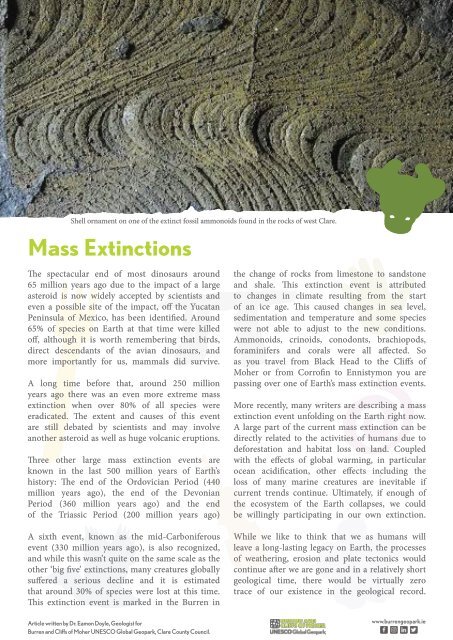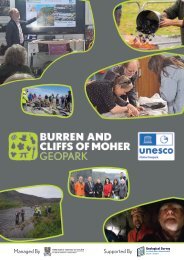Burren and Cliffs of Moher UNESCO Global Geopark - Geology
A collection of articles about the geology in the Burren and Cliffs of Moher UNESCO Global Geopark written by Dr Eamon Doyle - Geopark Geologist
A collection of articles about the geology in the Burren and Cliffs of Moher UNESCO Global Geopark written by Dr Eamon Doyle - Geopark Geologist
You also want an ePaper? Increase the reach of your titles
YUMPU automatically turns print PDFs into web optimized ePapers that Google loves.
Shell ornament on one <strong>of</strong> the extinct fossil ammonoids found in the rocks <strong>of</strong> west Clare.<br />
Mass Extinctions<br />
The spectacular end <strong>of</strong> most dinosaurs around<br />
65 million years ago due to the impact <strong>of</strong> a large<br />
asteroid is now widely accepted by scientists <strong>and</strong><br />
even a possible site <strong>of</strong> the impact, <strong>of</strong>f the Yucatan<br />
Peninsula <strong>of</strong> Mexico, has been identified. Around<br />
65% <strong>of</strong> species on Earth at that time were killed<br />
<strong>of</strong>f, although it is worth remembering that birds,<br />
direct descendants <strong>of</strong> the avian dinosaurs, <strong>and</strong><br />
more importantly for us, mammals did survive.<br />
A long time before that, around 250 million<br />
years ago there was an even more extreme mass<br />
extinction when over 80% <strong>of</strong> all species were<br />
eradicated. The extent <strong>and</strong> causes <strong>of</strong> this event<br />
are still debated by scientists <strong>and</strong> may involve<br />
another asteroid as well as huge volcanic eruptions.<br />
Three other large mass extinction events are<br />
known in the last 500 million years <strong>of</strong> Earth’s<br />
history: The end <strong>of</strong> the Ordovician Period (440<br />
million years ago), the end <strong>of</strong> the Devonian<br />
Period (360 million years ago) <strong>and</strong> the end<br />
<strong>of</strong> the Triassic Period (200 million years ago)<br />
the change <strong>of</strong> rocks from limestone to s<strong>and</strong>stone<br />
<strong>and</strong> shale. This extinction event is attributed<br />
to changes in climate resulting from the start<br />
<strong>of</strong> an ice age. This caused changes in sea level,<br />
sedimentation <strong>and</strong> temperature <strong>and</strong> some species<br />
were not able to adjust to the new conditions.<br />
Ammonoids, crinoids, conodonts, brachiopods,<br />
foraminifers <strong>and</strong> corals were all affected. So<br />
as you travel from Black Head to the <strong>Cliffs</strong> <strong>of</strong><br />
<strong>Moher</strong> or from Corr<strong>of</strong>in to Ennistymon you are<br />
passing over one <strong>of</strong> Earth’s mass extinction events.<br />
More recently, many writers are describing a mass<br />
extinction event unfolding on the Earth right now.<br />
A large part <strong>of</strong> the current mass extinction can be<br />
directly related to the activities <strong>of</strong> humans due to<br />
deforestation <strong>and</strong> habitat loss on l<strong>and</strong>. Coupled<br />
with the effects <strong>of</strong> global warming, in particular<br />
ocean acidification, other effects including the<br />
loss <strong>of</strong> many marine creatures are inevitable if<br />
current trends continue. Ultimately, if enough <strong>of</strong><br />
the ecosystem <strong>of</strong> the Earth collapses, we could<br />
be willingly participating in our own extinction.<br />
A sixth event, known as the mid-Carboniferous<br />
event (330 million years ago), is also recognized,<br />
<strong>and</strong> while this wasn’t quite on the same scale as the<br />
other ‘big five’ extinctions, many creatures globally<br />
suffered a serious decline <strong>and</strong> it is estimated<br />
that around 30% <strong>of</strong> species were lost at this time.<br />
This extinction event is marked in the <strong>Burren</strong> in<br />
Article written by Dr. Eamon Doyle, Geologist for<br />
<strong>Burren</strong> <strong>and</strong> <strong>Cliffs</strong> <strong>of</strong> <strong>Moher</strong> <strong>UNESCO</strong> <strong>Global</strong> <strong>Geopark</strong>, Clare County Council.<br />
While we like to think that we as humans will<br />
leave a long-lasting legacy on Earth, the processes<br />
<strong>of</strong> weathering, erosion <strong>and</strong> plate tectonics would<br />
continue after we are gone <strong>and</strong> in a relatively short<br />
geological time, there would be virtually zero<br />
trace <strong>of</strong> our existence in the geological record.<br />
www.burrengeopark.ie


















